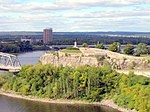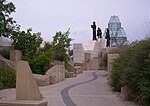Global Centre for Pluralism

The Global Centre for Pluralism (French: Centre mondial du pluralisme) is an international centre for research, education and exchange about the values, practices and policies that underpin pluralist societies. Based in Ottawa, Ontario, Canada, the Centre seeks to assist the creation of successful societies. The Global Centre for Pluralism is an international initiative of Aga Khan IV, 49th hereditary Imam of Ismaili Muslims, and was established jointly with the Government of Canada in 2006. It is located in the former Canadian War Museum building along Ottawa's Sussex Drive and was officially opened with Governor General of Canada, the Right Honourable David Johnston on May 16, 2017.
Excerpt from the Wikipedia article Global Centre for Pluralism (License: CC BY-SA 3.0, Authors, Images).Global Centre for Pluralism
Sussex Drive, Ottawa Lowertown (Rideau-Vanier)
Geographical coordinates (GPS) Address Phone number Website Nearby Places Show on map
Geographical coordinates (GPS)
| Latitude | Longitude |
|---|---|
| N 45.430602 ° | E -75.698746 ° |
Address
Global Centre for Pluralism
Sussex Drive 330
K1N 0C7 Ottawa, Lowertown (Rideau-Vanier)
Ontario, Canada
Open on Google Maps









